#Mythological Stories
Text

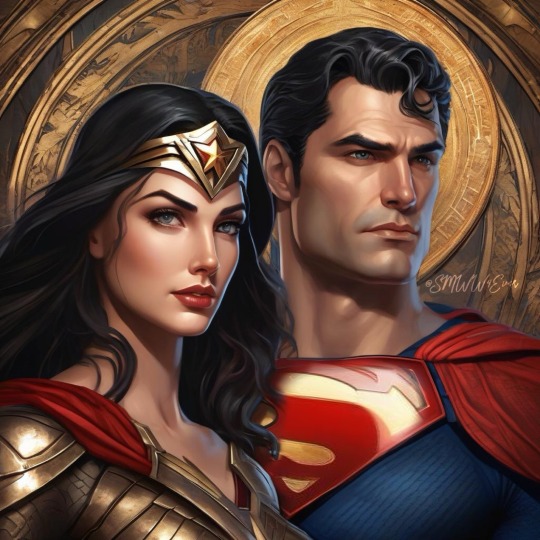
Superman and Wonder Woman as Church Icons
Medieval Nuances
#superwonder#smww4ever#superman#supermanwonderwoman#wonderwoman#truelove#superman wonderwoman#lovebirds#powercouple#supermanxwonderwoman#orthodox christianity#icons#kal and diana#diana and kal#mythological stories
12 notes
·
View notes
Text








Ice fairies (ice queens) 🧚🏻♂️🧊❄️
https://www.youtube.com/shorts/GpSZM4hwH2A
#fantasycore#spirituality#spiritualgrowth#spiritual awakening#fae#fairy tale#fairycore#faerie#fairy aesthetic#fairies#fairy#fairy tail#fairy tales#fairy art#ice queen#snow#water#iceland#elemental#elementals#fantasy#myth#mythology and folklore#mythological creature#mythological stories#fantasy art#celebrity crush#celebrity#celebs#actress
5 notes
·
View notes
Text
"Unveiling the Mystique of Antiquity: A Journey Through 'The Myths and Legends of Ancient Greece and Rome' by E. M. Berens"

In the realm of classical mythology, E. M. Berens' "The Myths and Legends of Ancient Greece and Rome" stands as a venerable guide, beckoning readers into the enchanting tapestry of gods, heroes, and timeless tales. As I embarked on this literary odyssey, I found myself captivated by the author's adept storytelling and his ability to breathe life into the ancient narratives, making them accessible and engaging for a contemporary audience.
Berens' comprehensive exploration begins with the origins of the Greek and Roman pantheons, tracing the lineage of deities and the epic events that shaped their divine realms. The book then unfurls a rich tableau of myths, ranging from the birth of the cosmos to the heroic exploits of figures like Hercules, Perseus, and Odysseus. Each narrative is meticulously crafted, with Berens providing insightful commentary that delves into the symbolic and cultural significance of these tales.
What sets Berens' work apart is his knack for blending academic rigor with a storyteller's flair. He navigates the intricate genealogies and complex relationships of the gods with clarity, ensuring that readers, whether well-versed in classical mythology or newcomers to the subject, can easily follow the intricate narratives. The prose is eloquent, evoking the grandeur of ancient civilizations while maintaining a modern accessibility that makes the myths feel vibrant and relevant.
One of the standout features of the book is Berens' meticulous attention to detail. He not only recounts the well-known myths but also unearths lesser-known stories, providing a holistic view of the ancient mythological landscape. The inclusion of lesser-known tales adds depth to the reader's understanding, creating a nuanced portrayal of the diverse characters and themes that populate the classical mythos.
"The Myths and Legends of Ancient Greece and Rome" also serves as a valuable cultural resource, shedding light on the moral and philosophical underpinnings of these ancient societies. Berens explores how these myths were interwoven into the fabric of daily life, shaping religious practices, artistic expressions, and even political ideologies. This contextualization enriches the reader's appreciation for the enduring impact of classical mythology on Western culture.
While Berens' work is undoubtedly a comprehensive and illuminating resource, it is not without its limitations. The book, originally published in the late 19th century, reflects the perspectives and biases of its time. Some readers may find aspects of the text to be outdated or culturally insensitive. Additionally, the absence of in-depth analysis or critical engagement with the source material may leave scholars wanting more scholarly depth.
In conclusion, "The Myths and Legends of Ancient Greece and Rome" by E. M. Berens is a captivating journey through the timeless narratives of classical mythology. Berens' storytelling prowess, coupled with his dedication to presenting a comprehensive overview, makes this book a valuable companion for anyone seeking to explore the rich tapestry of ancient Greek and Roman myths. The author's ability to strike a balance between academic rigor and engaging storytelling ensures that this work remains an enduring classic in the realm of mythological literature.
E. M. Berens' "The Myths and Legends of Ancient Greece and Rome is available in Amazon in paperback 16.99$ and hardcover 23.99$ editions.
Number of pages: 422
Language: English
Rating: 9/10
Link of the book!
Review By: King's Cat
#Ancient Greek mythology#Roman mythology#Classical legends#Mythological pantheon#Gods and goddesses#Heroes and heroines#Mythical narratives#Epic tales#Greek and Roman deities#Mythological stories#Berens' mythology#Ancient epics#Mythical characters#Classical literature#E. M. Berens myths#Mythological retellings#Legendary adventures#Divine genealogies#Classical civilization#Mythological symbolism#Cultural significance#Moral themes#Philosophical concepts#Mythological interpretations#19th-century literature#Ancient cosmogony#Mythical creatures#Heroic exploits#Classical deities#Greek and Roman folklore
6 notes
·
View notes
Text
The Hunt that Hunts Back
-----------------------------------------------

-----------------------------------------------
" Hunter goes missing, body found days later, dismembered in forest " The newspaper read as Gabriel read it, sipping his coffee as he sat outside his cabin. " Probably a bear he was too weak to kill " He muttered amused as he finished drinking his coffee deciding to get ready to go on a quick hunt.
As Gabriel finished getting ready, he grabbed his hunting knife and gun as he went outside into the forest. The leaves crunched under him as he walked, it was a quiet morning in the forest, the birds chirping, the leaves on the trees dancing with the wind. He came across a rabbit, crouching down, and pointed his shotgun at the leg of the rabbit, he shot it causing it to almost scream in pain, he came closer taking out his hunting knife, giving the rabbit a slice to the back. As the rabbit bled out, in pain, he watched amused, when it finally died he got up grabbing the dead rabbit and going into his cabin to continue his day, seemingly proud of himself.
Gabriel skinned the rabbit, making sure no fur is left then he gutted it to cook, as he turned on the oven he placed the rabbit onto the pan, keeping the fire at medium heat he began pan-cooking it. As it cooked he prepared the seasonings, Basil, Chives, Saffaron, Parsley, Rosemary, Chervil, Paprika, and pepper with some salt, As the meat began cooking through a bit he began seasoning it before leaving it to simmer as he cut some onions and garlic to cook with the meat, after the meat fully cooked he placed it on a plate and began eating.
After his long day of hunting and cooking he decided to watch some tv and go to sleep, unaware and vulnerable to the night beasts. Suddenly he woke up to a phone call from his mother, as he picked up the phone " Hey ma, " He said into the phone, but all he heard back was heavy breathing, he kept on asking before he hung up thinking it was just an accidental call and he went back to sleep.
At 2:30 in the morning, Gabriel woke up to tapping to the window, he groaned as he looked over to the window, seeing a flash of white with a bit of red, he took a deep breath never seeing an animal looking like that, he grabbed his shotgun which he kept next to his bed, he went downstairs for some water just to calm him down a bit, he jumped a bit as he heard in his cabin.
As he went to check it out he saw.. His mother? "hey ma? What are you doing here..? " He asked as he looked at what seemed to be his mother, but he got no response, he then heard a creek behind him, looking behind him he saw who he thought was best friend, looking at him with glazed eyes, "mark..? What are you two doing here? " he asked a bit scared.
Suddenly he heard his mother scream as he looked over to her he saw a black blur holding her in a head lock, you could not see any human characteristics other than a human body that was a black blur. "LET HER GO!" He screamed, scared, Then the blurred "person" Pulled out a gun pointing it to his mother's head.
"NO! " Gabriel yelled as he pointed his shotgun at the black blur, "Let her go before i shoot! " He yelled, when the "person" didnt let his mother go he shot them just for them to disappear and for him to realize he shot his mother, "NO! " he said running to her corpse as he looked at her, her head looked mutated given the bullet went through the bottom of her chin since the "person" was forcing her to look up.
"You killed her. " He heard what seemed to be his best friend say, as he turned around to yell at him to help him, he saw a black beast that almost looked like a demonic, humanoid rabbit but the rabbit part was only the ears and paws, "wh-what are you?! " he yelled as he scrambled to get his gun, When he reached for it his back hit something as he looked up he saw another humanoid-demonic but this time it was a deer, he screamed just for the deer to kick him causing his breath to hitch as now he was surrounded, the taxidermys on the wall all turning their head in his direction.
The black rabbit walked over and held him up making him stand upright while the white deer raised up its claws and gave him a scratch to the chest, the man screamed but the scratch was not strong enough to kill him, just make him bleed out, it then chanted something placing its paw on his bleeding chest, he then felt a burning pain throughout his body. He attempted to squirm but with the black rabbit holding him in place, he just couldn't.
The deer plunged its paw into his stomach as it began slowly and painfully pulling out his intestines, making sure he felt every single thing, then it began ripping out his organs till all that was left was his lungs and his heart, he was somehow still alive throughout the whole thing, then it began skinning him as he groaned wanting to scream in pain but he just couldn't.
Then finally, it crushed his skull, then the creatures disappeared making it seem like they were never there, he just happened to get murdered. And maybe thats why you should give your hunts a quick death or they might come back to get you when you least expect it.
-----------------------------------------------
A/N: This is one of the first stories ive ever written i hope yall like it <3
#Horror story#horror writing#mythological stories#Forest story#hunt story#The Red Rabbit#Mythological creatures#Thriller#Creepy story
2 notes
·
View notes
Text
A Breaking of Crows and Dogs - The Storyteller’s Guide to the “Dog Days” of Summer: The Folklore & Mythologies of the Autumnal Equinox
Twitter
Patreon
GitHub
LinkedIn
YouTube
This is one of my favorite moments in life. Every year, there is this moment when the tides and energies of some corporeal atmosphere beyond my understanding begins shifting. This usually occurs a week or two before the autumnal equinox.
This is when the crows return. It’s 5am and I’m lying in bed thinking of you, or one of you, out there, reading…

View On WordPress
#Ancient Cultures#Ancient Egypt#Celestial Phenomenon#Chinese folklore#creative inspiration#creative writing#Cultural References#Divine Beings#Divine Conflict#Dog Days#Folklore Tales#Folklore Traditions#Global Interpretations#greek mythology#Greek symbolism#Mythological Creatures#Mythological Stories#Narrative Inspiration#Nile Flood#Ominous Period#Roman Superstitions#Seasonal Celebrations#Seasonal Legends.#Seasonal Myths#Sirius#storytelling#Summer Heat#Summer Mythology#Three-Legged Sun Crow#world building
2 notes
·
View notes
Text
145K notes
·
View notes
Text
Yes, Greece still exists, we didn't all die 2000 years ago. Yes, people speak Greek. You people are so fucking stupid for real. So many of you claim to love ancient shit but can't even acknowledge the actual living culture of the people whose mythology and classics you romanticize. You keep leaving annoying comments about how you just forget Greek people still exist, thinking you're being quirky because you love ancient stuff soooo much that you forgot about the people it came from. You think about it so little you don't even realize that an actual Greek person has to read this shit, making it clear how little you actually care about the culture beyond the romanticized (and westernized) mythology. Don't claim you love Greece, don't use our mythology anymore if you can't acknowledge that we're still around without making it about how little you think about us. It's mind boggling that you'd think a Greek person would read this and think you're anything but obnoxious. Explode.
#this post is edited because you're all annoying. maybe I'll turn it back someday#it sucks that people can't even be normal about a funny family story once the fact that we're greek comes into the fold#suddenly its all about blorbofied mythology shit and idiots saying ''GREECE IS REAL???? 🤯🤯🤯🤯'' yeah percy j*ckson didnt make it up#maybe it would be less annoying if they weren't all saying it like I'd think it's funny that they don't know we exist instead of like#disturbing on a personal level. like what the fuck#man if you can't acknowledge we exist in real life just name your oc Icarus something else idgaf#so yeah explode. Skase. Voulos'to. Valto mesa sto katamalakismeno mouni tis mana's sou. Psophise. etc.
31K notes
·
View notes
Text
So, this thread is for @Spirited_Gal , who is a wonderful person & author. She reached out curious about Asian storytelling structures and techniques, then links to South Asian ones. This became a convo about native/common/historical structures/styles/techniques from South Asia.
So, let's get into some loosely (just to make y'all aware, without turning this into an academic essay because it easily can - but I do not have time for that, and am not being paid for that writing, and it could be a lot when fully fully fleshed out).
Katha | Kathya: this is an Indian style of storytelling rooted in religious stories (mythology) - the performances are ritual events in Hindiusm. Sikhism holds a different take on it but somewhat related in that there is a focus on religious discourse, taking things apart, -
questioning meaning/interpretations, & then using this to teach scriptures for a moral/religious education - directing beliefs & practices. But the purpose regardless when reduced to the simplest is the same: the moral/religious education & impartation of societal good values to people through the stories.
Usually the stories and this style are performed with a class of people who are both priests and narrators (narrators/storytellers have a massively important role in South Asian culture that they cannot be understated and undervalued, especially-
considering so much of the religious history | myths, epics/stories were orally performed and passed down. Aural (listening/hearing) pleasure are just as important as music and song and dance accompany these performances, and couplets, hymns are common as well.
Anyways, Katha is its own style focused on the religious epics like Ramayama. These stories as mentioned feature a storyteller proficient in classic music, oration, accompanied by dance/song at times, and involve story digression points - if that sounds familiar :throws copy of The First Binding at your face (lovingly).
This particular style is called: Kathakalakshepa.
Another style of Katha is: Purana-Pravachan - built on/around expounding the Puranas, a vast collection of folklore, stories, poems, legends, and more. They are heavily layered with-
deep symbolism, diverse, incorporation tales of all sorts including sciences and topics like cosmology and cosmogony (not the same). This style focuses on the spiritual interpretation of these stories while reciting them.
Folk Narratives (and I have another thread on specific ones such as Panchatantra and Jataka tales which I have talked about and have been argued by some experts to contribute | inspired to 30-50 percent of western nursery tales, ballads, "fairy" tales, as well as some (some not all, not many) middle eastern ones. Some. These are usually narrated with drumming and bow-string instruments. You might see more of these in future Tremaine novels. Perhaps even book two <.<
One of the most common type of story within the folk narrative is particularly - the heroic ballad.
Another specific style here is the Burra Katha - an oral storytelling technique that comes from the Jangam Katha (an order of religious monks associated with Shiva). It incorporates many of things I've mentioned before: prayer, drama, dance, songs, poems, humor (lewd and tame), and usually focuses on mythological stories, or interpretations to focus on modern social issues. Interesting fact, Burra refers to tambura - a stringed instrument with a hollow shell. In Telegu, the word Burra means brain. The shell of the instrument so resembles a human skull (metal! or...gothic. w.e.), it's made of baked clay, pumpkins, or soft metals like brass/copper. In this style, the narrator doesn't just narrate, they play the instrument and dances to the music. South Asia has very little just tell a story traditions.
They're all performances. You will move, you will dance, you will evoke, sing, riddles, lessons, so on. :Gestures to Ari:
Okay - that's it that I want to talk about Katha (yep one tradition/style with varied structures). Just one...see how diverse it gets.
NOW, CLASS:
Kirtan | Keertan: It's narrating, reciting, telling or describing a story or an idea. Wait isn't that the same? No. Because it's a genre of religious performance arts but you're not necessarily breaking down a religious epic/myth a certain way. Instead, you are focused on the
performance of them, many times in a group, with multiple singers, each of whom recite/focus on the name of a specific deity, or a legend, and then you perform that part, very heavy on emoting, evoking that aspect to the audience, the romance, the heroism, and then use multiple singers to discuss that. This particular style is built to engage the audience.
You bring the audience in on the chanting, on the songs, or reply to the singers. You're not lecturing and teaching a moral/spiritual education here. You're performing them and involving the crowd
That IS different. This is a collective performance. Just because you might cover similar topics as Katha, for example, doesn't mean it's the same thing.
That's like saying anything involving a four chord progression is the same (I know someone musicy will bring up a joke about how...yeah they're all the same. I KNOW WHERE YOU'RE GOING WITH THAT BUT YOU KNOW WHAT I MEAN. CHILLLLL).
Anyways, what specifically makes Kirtan different is the fact that it's not required to be educational, and it's focused on shared performances. Katha can be performed by ONE person.
Kirtan again is commonly a call-and-response style performance.
I've already talked about Puranas and Jatka Tales and Panchatantra before (you can look those up in my other thread). Also styles of storytelling because of what they entail in their collections, diversity of topics, and varied styles between them in the presentation. They're not just "works" but it's how they're collected/presented and what they cover. That matters.
Hitopadesha: Beneficial Advice. This is an Indian text, written in, as you can imagine, Sanskrit. It's compromised of fables with human and animal characters and focuses on, you guessed it, imparting advice - maxims, so on. Things involving political affairs, life advice, and is delivered in simple and elegant language. It is said in fact to actually predate the Panchatantra (which I've shared is already one of the oldest things out of there. This is said at times to be the Panchatantra before Panchatantra )
The argued point of this particularly story and its structure of being four books, really, is to both encourage the proficiency of people reading it in Sanskrit expression (writing, poetry, more), and imparting wisdom/good behavior. Note, this is not focused on religious/ mythological connections. These are some of the oldest folklore/folktale/fable style stories. You can convey lessons/wisdom/life advice without a religious epic. Though, note, religious figures DO appear and can in this style. Some examples from within:
Book one: (Translated title) How to gain a friend (some of y'all might need this with how you behave online). It begins with a statement on how the wise and sincere friends might often appear poor or destitute, however, they are the ones who more often/earnestly help one achieve true success in life. It focuses on finding friends of good quality, doing this through many particular animal stories such as: The traveler and the tiger. Or, the deer, the jackal, and the crow. The old man & his young wife. The huntsman, deer, the boar, & the serpent & jackal.
Frame Narrative: I think I've talked about this one so much it'll be mildly depressing if I have to really break this one down. But, ahem. Sandwich narrative, kind of self explanatory. Story (or stories) within a story. You have a main narrative and or narrator (hi Ari) set the stage for more emphasized and secondary narratives within (going as deeply layered as you want). The legendary South Asian epic, Mahabharta is the earliest example of Frame Narratives we have, along with Ramayama, Panchatantra, The Seven Wise Masters, and Vikram Vetala (or Vikram the Vampire oh yes, Indian Vampire - technically flesh eating demon, long story. HA. GEDDIT?). Anyways some other examples from other cultures are: 1,001 Nights, The Decameron, and Canterbury Tales. Parts of the Odyssey employ this too, the beginning, where Odysseus tells of his time in the court of King Alcinous.
Mary Shelley's, Frankenstein, has multiple framed narratives in it. Neil Gaiman's used it in parts of Sandman. But we're getting away from the South Asian history/roots.
Next:
Qissa | Kisse | Kissa (NOTE: This is not solely an Indian origin, but a fusion that comes out of Islamic/Persian heritage that developed a different localized form to Punjabi and Bangladeshi people once introduced and changed for them through migration). The word Qissa is Arabic for epic legend or folk tale. It's regularly common in Indo-Aryan languages like Punjabi, Hindi, Urdu, so on.
You can also translate it as: interesting story (which is a whole own genre - something that has led me to butting some heads with people in the biz when I explain YOU DO NOT NEED TO HAVE A STANDARD PLOT STRUCTURE FROM THE WEST. SCREAMS. :Jabs at one piece, an epic adventure fiction with a numinous goal still in the distance after 20 years, but strung together with tightly woven character driven and location arcs - it quite literally follows the history of great, grand, ADVENTURE fiction, promising more than anything, a great adventure story in pursuit of a goal. The end).
Anyways, I digress.
Punjabi Qisse/Kisse focuses on stories of love, passion, betrayal, and sometimes a common man's revolt against a larger system. Stories of friendship, loyalty, love. These are usually sung and performed. Poetry forms of this are VERY common (through all the mentioned cultures above, not just Punjabi). The Bengali style is similar (as obvy both evolved out of the Arabic tradition), just focusing more on Bengali culture and stories. They are all UTTERLY beautiful.
If you've read Tales of Tremaine (and wait for book two) you will catch these themes and notes as well.
It's almost like that series is trying to smash and share every freaking kind of storytelling technique and tradition I can from along the silk road because...there isn't one of those (golden road) in the book. Oh, wait. :blinks:
Kavya: This is a particular style of utterly beautiful poetry performed by court poets. It's a blend of prose and poetry focusing specifically on the flowery/hyperbolic uses of figures of speech, metaphors, and similes.
Sometimes you'll have pieces flowing through normalized prose and poetry in and out. That is NOT required in that specific way. It's just something that happens/can be done.
There is a very specific intentional use of that in the chapter, Brahm, in The First Binding, in where there is a creation/cosmogony story, performed in normalized prose, rhyming couplets and quatrains, with a mini section in verse.
That section is not actually Kavya, just inspired, as it is not a court epic, more drawing from the other requirement of a "short" lyrical work with those aspects I mentioned above.
There is Bhakti poetry: a specific poetic tradition from the 6th century focusing on celebrating the love and devotion for Hindu gods - showing one's mystical devotion to a god. It's devotional and religious, also focusing on condemning evils, promoting egalitarian values, transcending ideas of caste, gender, and restrictions. It hinges upon message of love.
Dastan: Is an Urdu storytelling tradition focused on epic tales of adventure, romance, chivalry (note, not only pakistani/urdu, other islamic cultures use this style). It is performed both orally and in written format.
This whole thread is JUST A PRIMER.
If you are interested, please take the time to go do a proper deep dive.
#poetry#books#book lore#folklore#folktale#folktales#Dastan#Bhakti#Punjabi#Mary Shelley#Frankenstein#Hitopadesha#katha#kathya#south asia#southeast asia#storytelling#traditions#history#storytelling techniques#writing techniques#writing craft#writers on tumblr#writer and poets#poems#poets on tumblr#narratives#narrators#writing#mythological stories
0 notes
Text
"Unveiling the Mystique of Antiquity: A Journey Through 'The Myths and Legends of Ancient Greece and Rome' by E. M. Berens"
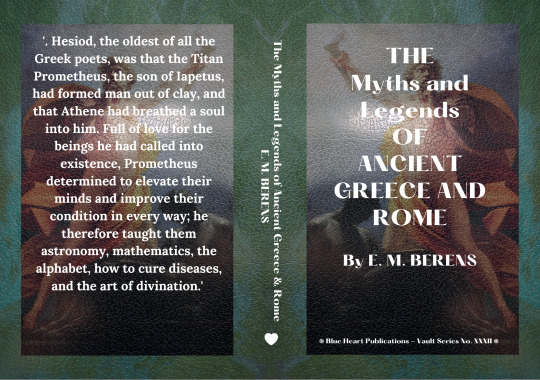
In the realm of classical mythology, E. M. Berens' "The Myths and Legends of Ancient Greece and Rome" stands as a venerable guide, beckoning readers into the enchanting tapestry of gods, heroes, and timeless tales. As I embarked on this literary odyssey, I found myself captivated by the author's adept storytelling and his ability to breathe life into the ancient narratives, making them accessible and engaging for a contemporary audience.
Berens' comprehensive exploration begins with the origins of the Greek and Roman pantheons, tracing the lineage of deities and the epic events that shaped their divine realms. The book then unfurls a rich tableau of myths, ranging from the birth of the cosmos to the heroic exploits of figures like Hercules, Perseus, and Odysseus. Each narrative is meticulously crafted, with Berens providing insightful commentary that delves into the symbolic and cultural significance of these tales.
What sets Berens' work apart is his knack for blending academic rigor with a storyteller's flair. He navigates the intricate genealogies and complex relationships of the gods with clarity, ensuring that readers, whether well-versed in classical mythology or newcomers to the subject, can easily follow the intricate narratives. The prose is eloquent, evoking the grandeur of ancient civilizations while maintaining a modern accessibility that makes the myths feel vibrant and relevant.
One of the standout features of the book is Berens' meticulous attention to detail. He not only recounts the well-known myths but also unearths lesser-known stories, providing a holistic view of the ancient mythological landscape. The inclusion of lesser-known tales adds depth to the reader's understanding, creating a nuanced portrayal of the diverse characters and themes that populate the classical mythos.
"The Myths and Legends of Ancient Greece and Rome" also serves as a valuable cultural resource, shedding light on the moral and philosophical underpinnings of these ancient societies. Berens explores how these myths were interwoven into the fabric of daily life, shaping religious practices, artistic expressions, and even political ideologies. This contextualization enriches the reader's appreciation for the enduring impact of classical mythology on Western culture.
While Berens' work is undoubtedly a comprehensive and illuminating resource, it is not without its limitations. The book, originally published in the late 19th century, reflects the perspectives and biases of its time. Some readers may find aspects of the text to be outdated or culturally insensitive. Additionally, the absence of in-depth analysis or critical engagement with the source material may leave scholars wanting more scholarly depth.
In conclusion, "The Myths and Legends of Ancient Greece and Rome" by E. M. Berens is a captivating journey through the timeless narratives of classical mythology. Berens' storytelling prowess, coupled with his dedication to presenting a comprehensive overview, makes this book a valuable companion for anyone seeking to explore the rich tapestry of ancient Greek and Roman myths. The author's ability to strike a balance between academic rigor and engaging storytelling ensures that this work remains an enduring classic in the realm of mythological literature.
E. M. Berens' "The Myths and Legends of Ancient Greece and Rome is available in Amazon in paperback 16.99$ and hardcover 23.99$ editions.
Number of pages: 422
Language: English
Rating: 9/10
Link of the book!
Review By: King's Cat
#Ancient Greek mythology#Roman mythology#Classical legends#Mythological pantheon#Gods and goddesses#Heroes and heroines#Mythical narratives#Epic tales#Greek and Roman deities#Mythological stories#Berens' mythology#Ancient epics#Mythical characters#Classical literature#E. M. Berens myths#Mythological retellings#Legendary adventures#Divine genealogies#Classical civilization#Mythological symbolism#Cultural significance#Moral themes#Philosophical concepts#Mythological interpretations#19th-century literature#Ancient cosmogony#Mythical creatures#Heroic exploits#Classical deities#Greek and Roman folklore
0 notes
Text
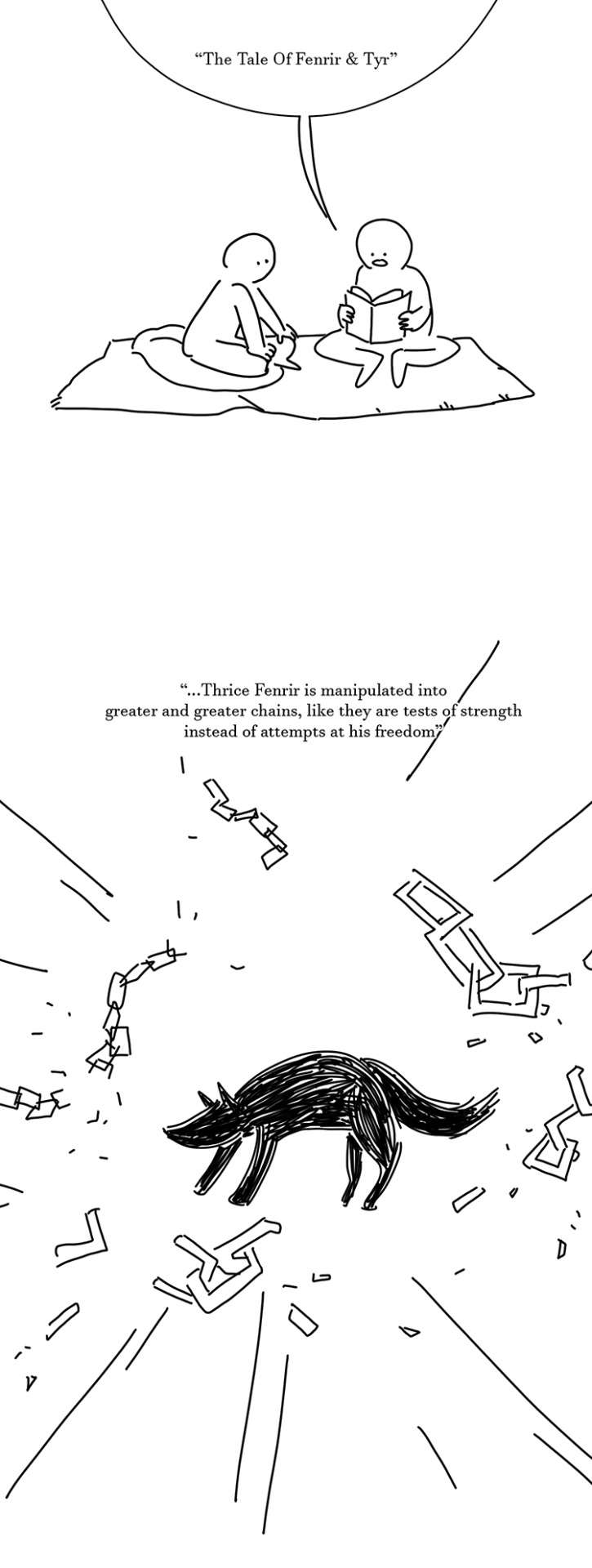
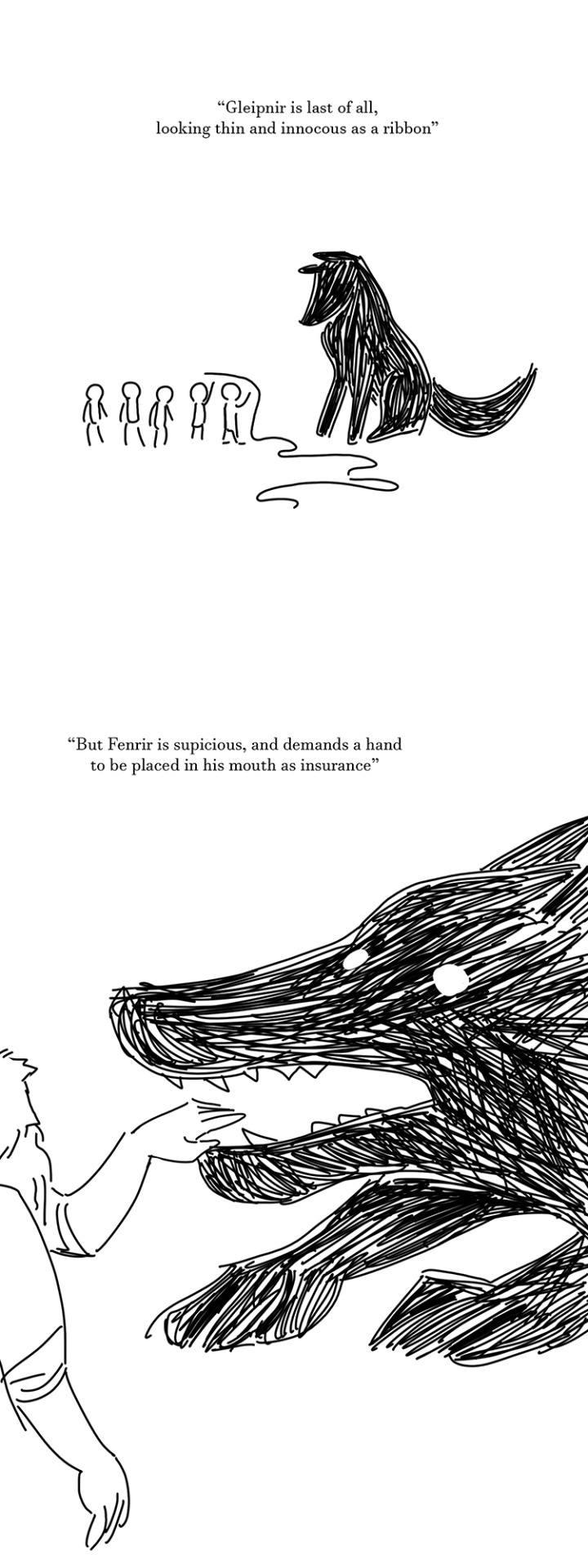

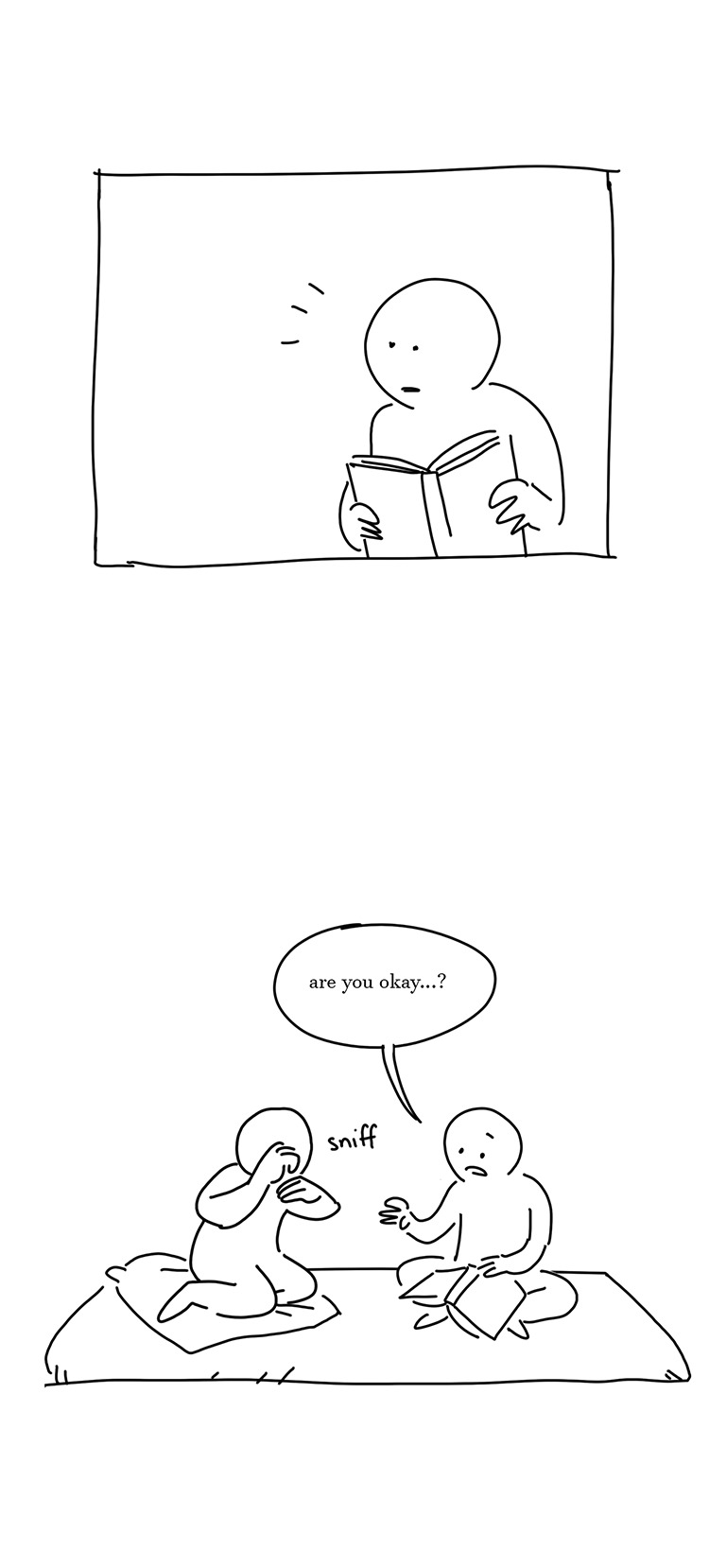

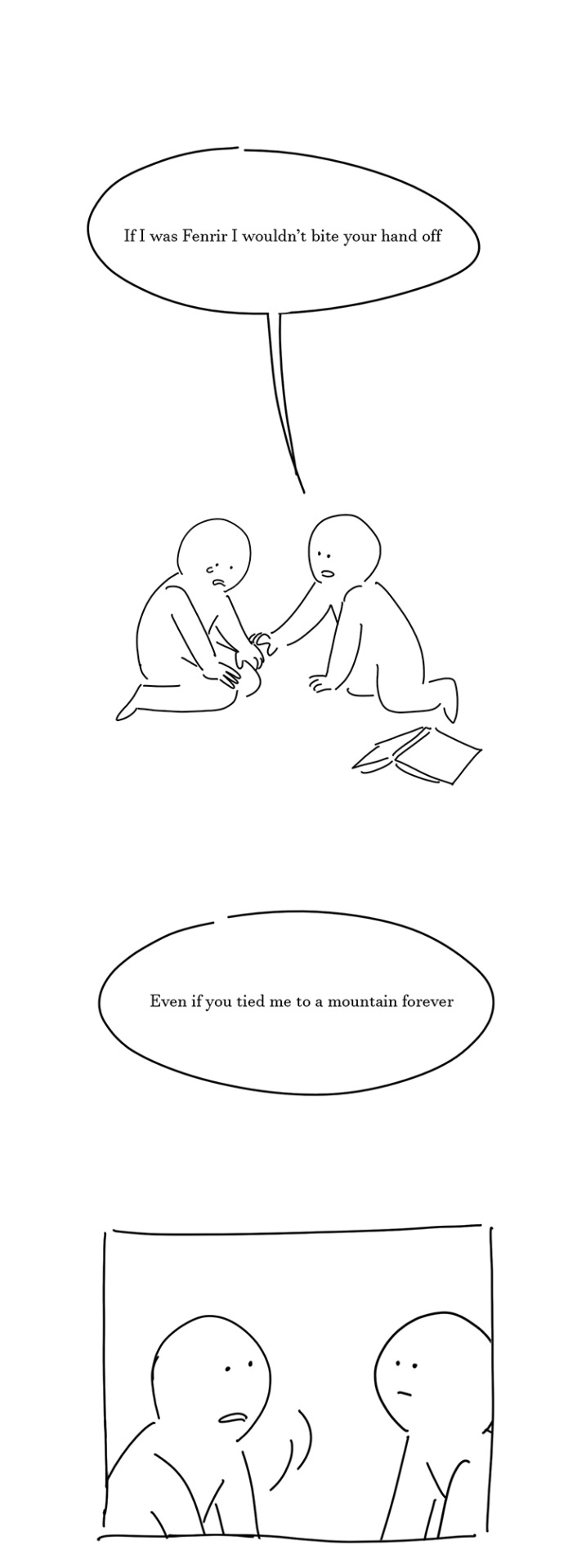


a comic with some norse mythology
#original comic#comic art#norse mythology#religion and lore#fenrir#tyr#my art#my comic#real story i listened to neil gaiman read that section of norse mythology in a youtube video and cried lol#side note go check out norse mythology by neil gaiman it bangs
14K notes
·
View notes
Text
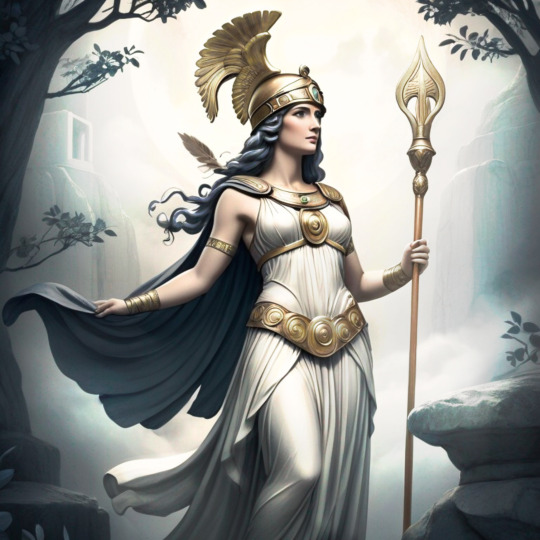
Athena, Ancient Greek Mythology
#athena goddess of wisdom#athene#athena#pallas athena#theoi worship#hellenic deities#hellenic polytheism#greek mythology art#ancient greek gods#mythological art#mythological stories#pagan gods
8 notes
·
View notes
Video
youtube
సముద్రంలో అగ్ని పర్వతాలకీ ప్రళయ కాలానికీ సంబంధం ఏంటి? Submarine Volcanoes
#youtube#submarine volcanoes#volcanoes#mahabharata#mahabharatam#voice of maheedhar#సముద్రం#mana maharshulu#mana rushulu#history#historical#hindu#hinduism#volcano#hindu mythology#mythological stories#historical stories#stories from hindu epics#animated stories#telugu stories#sri vatsasa gotra#srivatsasa#gotra#gotram#aurva#aurva maharshi#sage aurva#story of aurva
0 notes
Text
I do find it facinating how Dracula Daily has turned Dracula into a different kind of myth now that we're in its third year running. I've seen a few people compare it to Hadestown, or a timeloop. The enjoyment isn't JUST from engaging with the story now, it's engaging with the experience, and while the emails are still the same as previous years, we've been through this before.
The way we as an audience interact with this story and this way of telling the story changes the genre. Its no longer a gothic horror, classic lit story. It's become a mythology, a tragedy, a repeating loop. Jonathan Harker returns to the castle every year. Every year it happens again. And that changes it, builds up new mythos around it, even if the words stay exactly the same.
#wren rambles#dracula daily#modern mythology#i LOVE how mythology is developed#i LOVE how the way an audience interacts with a story changes#anyway i for one am very excited to hear from my good friend Jonathan soon!#hope hes going to have a great business trip im sure nothing will go wrong!
2K notes
·
View notes
Text
i love you fairy tales i love you folklore i love you myths i love you stories as old as humanity itself i love you oral traditions i love you characters carried through time on my ancestors’ tongues i love you story i’ve seen a million ways and want to see a million more i love you archetypes i love—
19K notes
·
View notes
Text
I was half asleep and thinking about all the stories like She’s The Man and Mulan (1999) where a woman dresses up like a man in order to do something ManlyTM and how they all inevitably fall in love with the masculinity of it all while still being women (or not, I guess, fiction is flexible and gender is more so)
and I went “give me a man who chooses to dress as a woman instead of resorting to violence. Give me a man who, in finding femininity and softness, can find himself. Give me a man who chooses kindness and love over war and aggression, but the only way he can do so is finding solace in the feminine. Not because femininity is inherently softer, but because society has told him as such. Give me a man who, through trial and error, finds himself learning to love the traditional women’s tasks he’s been clumsily attempting. Give me a man who could never truly fit in with other men, and the women around him protect him and love him unconditionally. Give me a man who cannot stand for himself at first, and then rises stronger together with the people who took him in”
And I realized that “give me a man who dresses as a woman in order to avoid going to war” is just. Achilles. And I want that classically animated movie now. I don’t even care if it’s sanitized like the Disney Renaissance Mulan or Hercules, in fact I’d enjoy that. I want Achilles to choose kindness and love and beauty over the war he never wanted to fight. I want a lighthearted, playful version of Achilles where there’s a happy ending. I know it’s a tragedy, but so were a lot of things that got animated at the time (not even Disney, Anastasia and Quest for Camelot come to mind as well) and I think he and Patroclus can have a happily ever after, too
I also want it to be gay, but I think that goes without saying
#patroclus#achilles#greek myth#greek mythology#animation#disney renaissance#late 1990s animation#happy stories#feminine men#she’s the man#mulan#feminine#femininity#masculine#masculinity#give me uwu soft boi that I can blorbo
3K notes
·
View notes
Text

so this might be a bit of reach but this scene had been bothering me for a while because why tf was sally jackson’s face not visible for the first few dialogues??? the initial answers i could think of were: a dramatic reveal or showing us young percy’s limited perspective on things, both literally and more figuratively.
but then i started thinking of how medusa tells percy that sally and her are kinda like sisters and how their stories have similarities and then my mind decided to connect sally’s head not being visible when she's first introduced to medusa being eventually beheaded, not only as a foreshadowing but also as an ominous warning of what could have been sally’s fate in an adjacent alternate universe if things didn’t go the way they had.

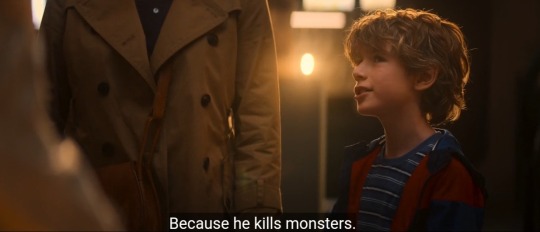
they have this entire conversation with the same angle, the same shot, with percy talking with a headless sally and then when they finally reveal her fully, THIS is the shot and THIS is the dialogue:

i mean percy and sally are roughly alligned with perseus and medusa’s head in the statue, a sort of twisted parallel of myth and reality.
i don't even care if this wasn't how it was intended but it seems intentional to me and i really adore this show’s cinematography and subtle hints through imaging and motifs and wkiqpwodkqlfk just had to get this out somewhere.
#percy jackon and the olympians#percy jackson#percy pjo#pjo#pjo fandom#pjo series#pjo tv show#pjo tv adaptation#walker scobell#pjo tv spoilers#pjo tv series#sally jackson#medusa#perseus#greek mythology#roman version of the medusa story
2K notes
·
View notes